TOYOTA COROLLA HATCHBACK 2020 Warranties & Maintenance Guides (in English)
Manufacturer: TOYOTA, Model Year: 2020, Model line: COROLLA HATCHBACK, Model: TOYOTA COROLLA HATCHBACK 2020Pages: 260, PDF Size: 8.54 MB
Page 11 of 260
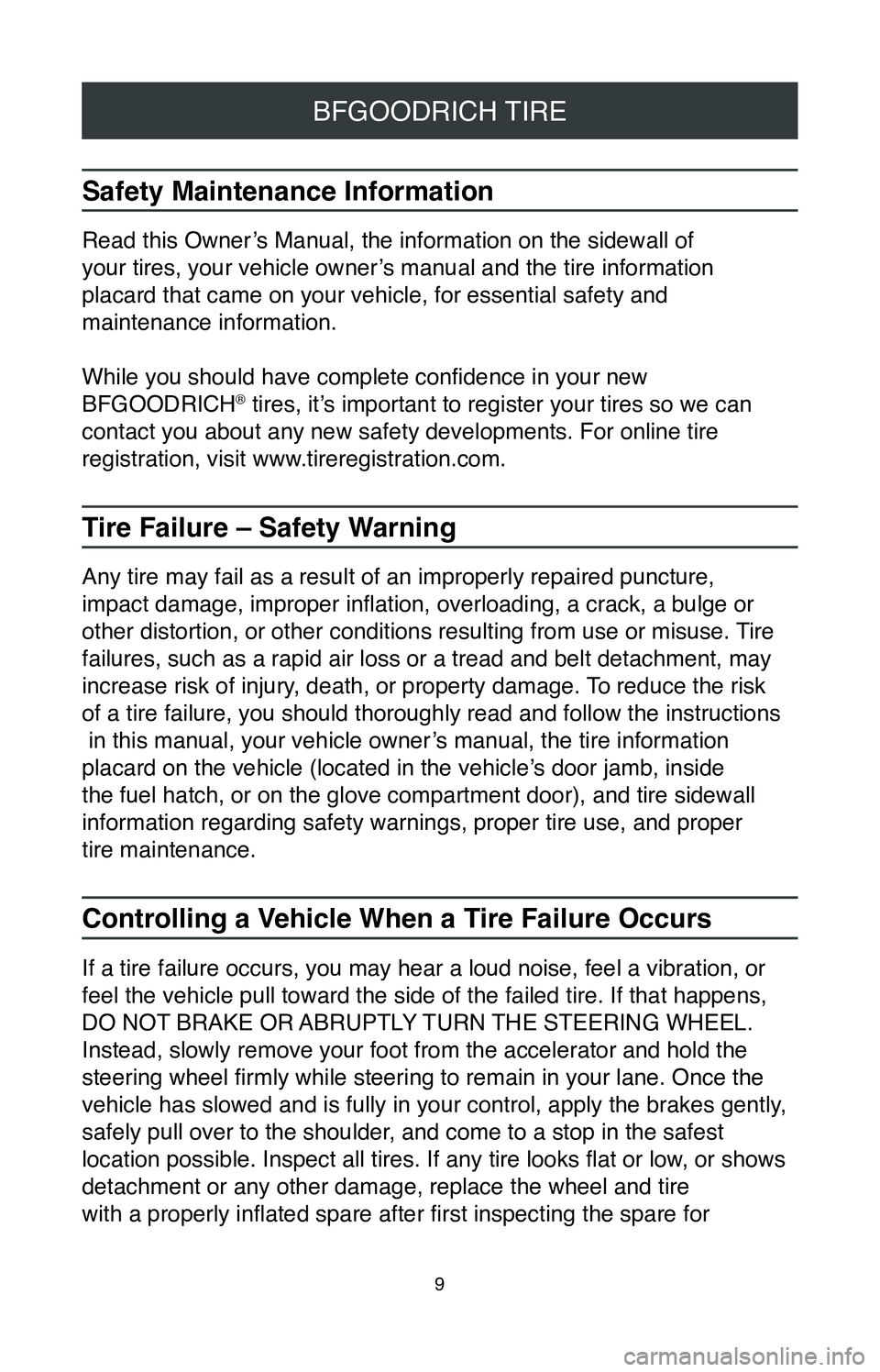
9
BFGOODRICH TIRE
Safety Maintenance Information
Read this Owner’s Manual, the information on the sidewall of
your tires, your vehicle owner’s manual and the tire information
placard that came on your vehicle, for essential safety and
maintenance information.
While you should have complete confidence in your new
BFGOODRICH
® tires, it’s important to register your tires so we can
contact you about any new safety developments. For online tire
registration, visit www.tireregistration.com.
Tire Failure – Safety Warning
Any tire may fail as a result of an improperly repaired puncture,
impact damage, improper inflation, overloading, a crack, a bulge or
other distortion, or other conditions resulting from use or misuse. Tire
failures, such as a rapid air loss or a tread and belt detachment, may
increase risk of injury, death, or property damage. To reduce the risk
of a tire failure, you should thoroughly read and follow the instruction\
s
in this manual, your vehicle owner’s manual, the tire information
placard on the vehicle (located in the vehicle’s door jamb, inside
the fuel hatch, or on the glove compartment door), and tire sidewall
information regarding safety warnings, proper tire use, and proper
tire maintenance.
Controlling a Vehicle When a Tire Failure Occurs
If a tire failure occurs, you may hear a loud noise, feel a vibration, o\
r
feel the vehicle pull toward the side of the failed tire. If that happen\
s,
DO NOT BRAKE OR ABRUPTLY TURN THE STEERING WHEEL.
Instead, slowly remove your foot from the accelerator and hold the
steering wheel firmly while steering to remain in your lane. Once the
vehicle has slowed and is fully in your control, apply the brakes gently\
,
safely pull over to the shoulder, and come to a stop in the safest
location possible. Inspect all tires. If any tire looks flat or low , or shows
detachment or any other damage, replace the wheel and tire
with a properly inflated spare after first inspecting the spare for
Page 12 of 260
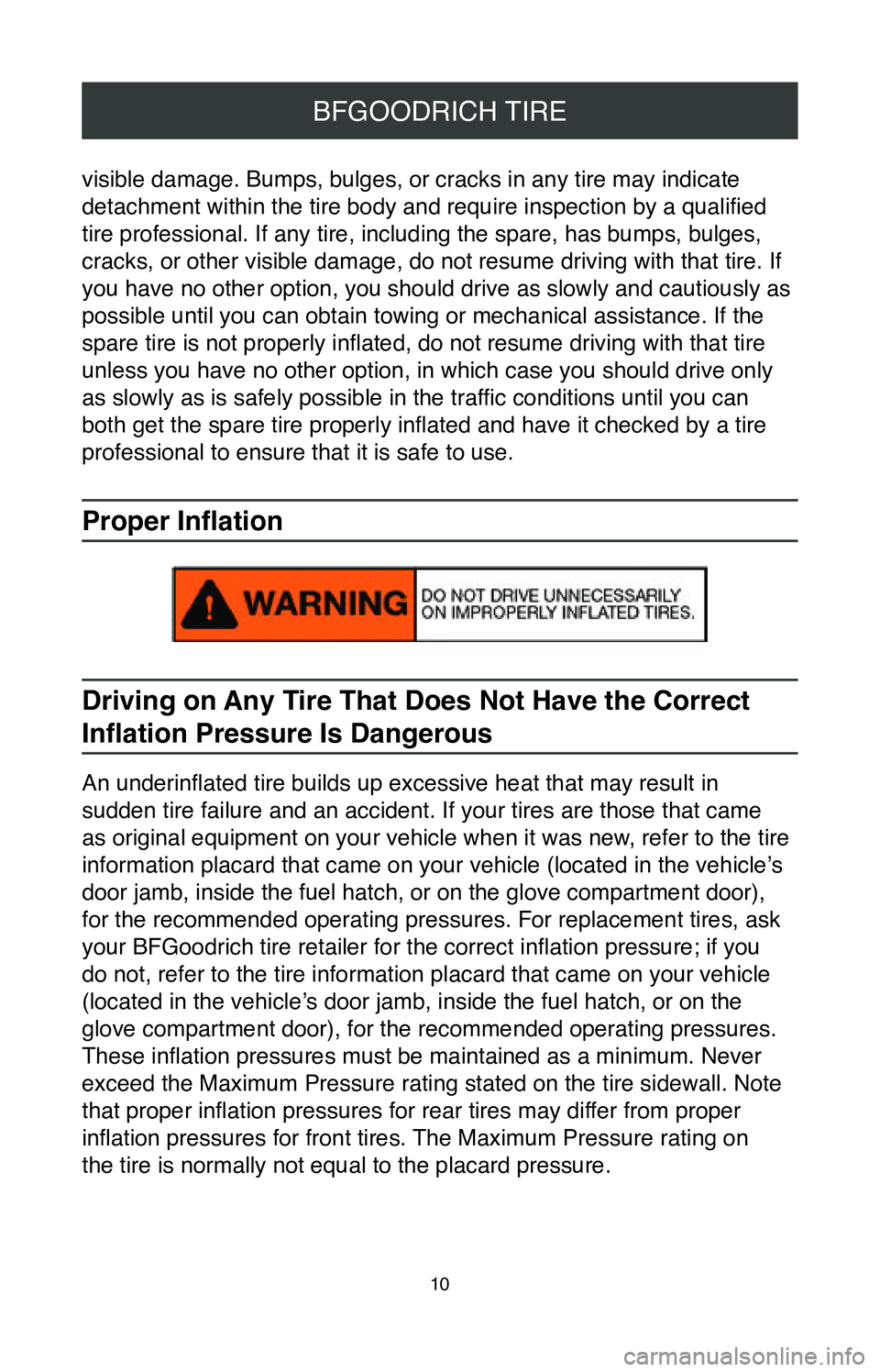
10
BFGOODRICH TIRE
visible damage. Bumps, bulges, or cracks in any tire may indicate
detachment within the tire body and require inspection by a qualified
tire professional. If any tire, including the spare, has bumps, bulges, \
cracks, or other visible damage, do not resume driving with that tire. I\
f
you have no other option, you should drive as slowly and cautiously as
possible until you can obtain towing or mechanical assistance. If the
spare tire is not properly inflated, do not resume driving with that tire
unless you have no other option, in which case you should drive only
as slowly as is safely possible in the traffic conditions until you can
both get the spare tire properly inflated and have it checked by a tire
professional to ensure that it is safe to use.
Proper Inflation
Driving on Any Tire That Does Not Have the Correct
Inflation Pressure Is Dangerous
An underinflated tire builds up excessive heat that may result in
sudden tire failure and an accident. If your tires are those that came
as original equipment on your vehicle when it was new, refer to the tire
information placard that came on your vehicle (located in the vehicle’s
door jamb, inside the fuel hatch, or on the glove compartment door),
for the recommended operating pressures. For replacement tires, ask
your BFGoodrich tire retailer for the correct inflation pressure; if you
do not, refer to the tire information placard that came on your vehicle \
(located in the vehicle’s door jamb, inside the fuel hatch, or on the
glove compartment door), for the recommended operating pressures.
These inflation pressures must be maintained as a minimum. Never
exceed the Maximum Pressure rating stated on the tire sidewall. Note
that proper inflation pressures for rear tires may differ from proper
inflation pressures for front tires. The Maximum Pressure rating on
the tire is normally not equal to the placard pressure.
Page 13 of 260
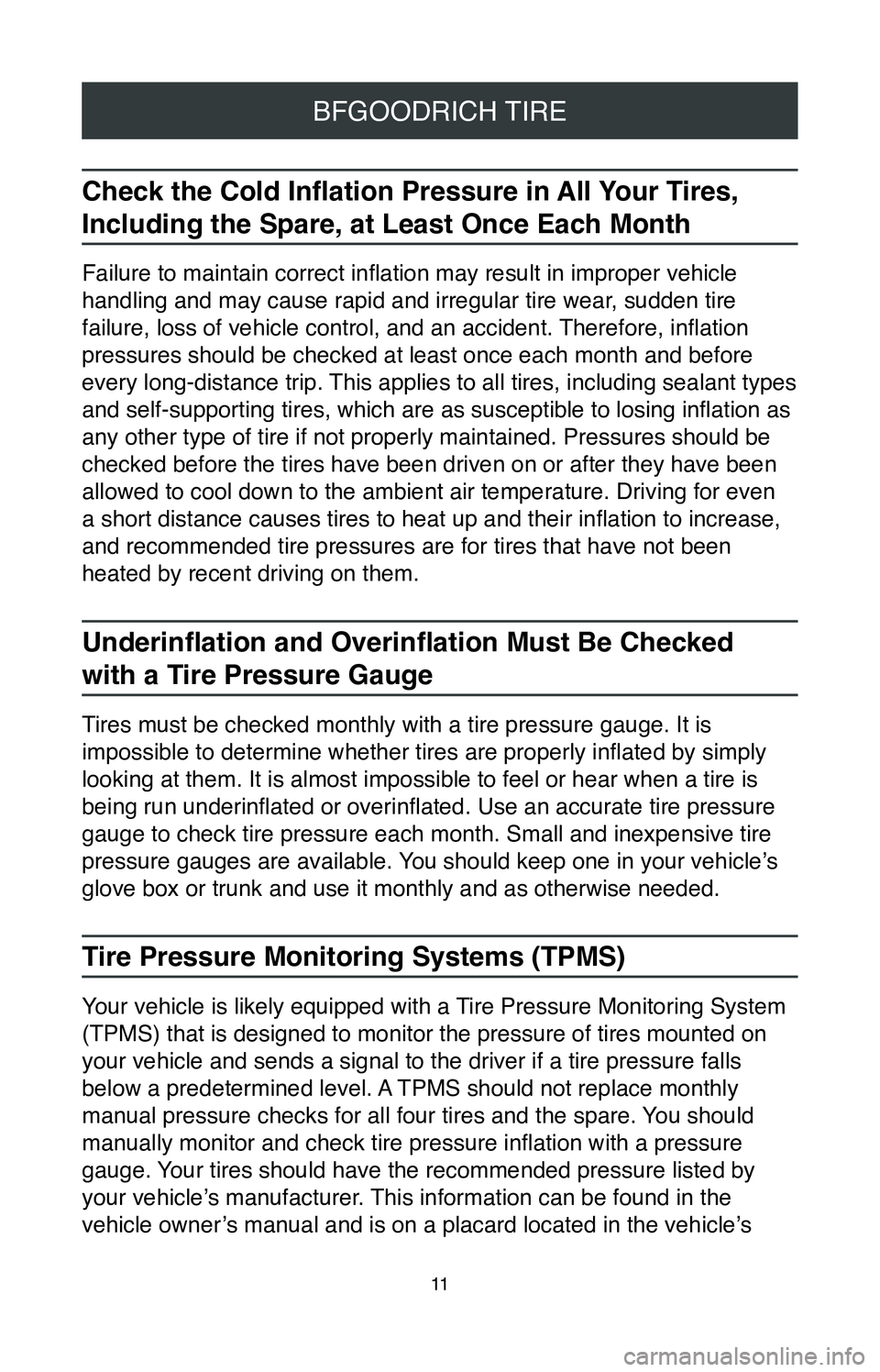
11
BFGOODRICH TIRE
Check the Cold Inflation Pressure in All Your Tires,
Including the Spare, at Least Once Each Month
Failure to maintain correct inflation may result in improper vehicle
handling and may cause rapid and irregular tire wear, sudden tire
failure, loss of vehicle control, and an accident. Therefore, inflation
pressures should be checked at least once each month and before
every long-distance trip. This applies to all tires, including sealant types
and self-supporting tires, which are as susceptible to losing inflation as
any other type of tire if not properly maintained. Pressures should be
checked before the tires have been driven on or after they have been
allowed to cool down to the ambient air temperature. Driving for even
a short distance causes tires to heat up and their inflation to increase,
and recommended tire pressures are for tires that have not been
heated by recent driving on them.
Underinflation and Overinflation Must Be Checked
with a Tire Pressure Gauge
Tires must be checked monthly with a tire pressure gauge. It is
impossible to determine whether tires are properly inflated by simply
looking at them. It is almost impossible to feel or hear when a tire is \
being run underinflated or overinflated. Use an accurate tire pressure
gauge to check tire pressure each month. Small and inexpensive tire
pressure gauges are available. You should keep one in your vehicle’s
glove box or trunk and use it monthly and as otherwise needed.
Tire Pressure Monitoring Systems (TPMS)
Your vehicle is likely equipped with a Tire Pressure Monitoring System
(TPMS) that is designed to monitor the pressure of tires mounted on
your vehicle and sends a signal to the driver if a tire pressure falls
below a predetermined level. A TPMS should not replace monthly
manual pressure checks for all four tires and the spare. You should
manually monitor and check tire pressure inflation with a pressure
gauge. Your tires should have the recommended pressure listed by
your vehicle’s manufacturer. This information can be found in the
vehicle owner’s manual and is on a placard located in the vehicle’s
Page 14 of 260
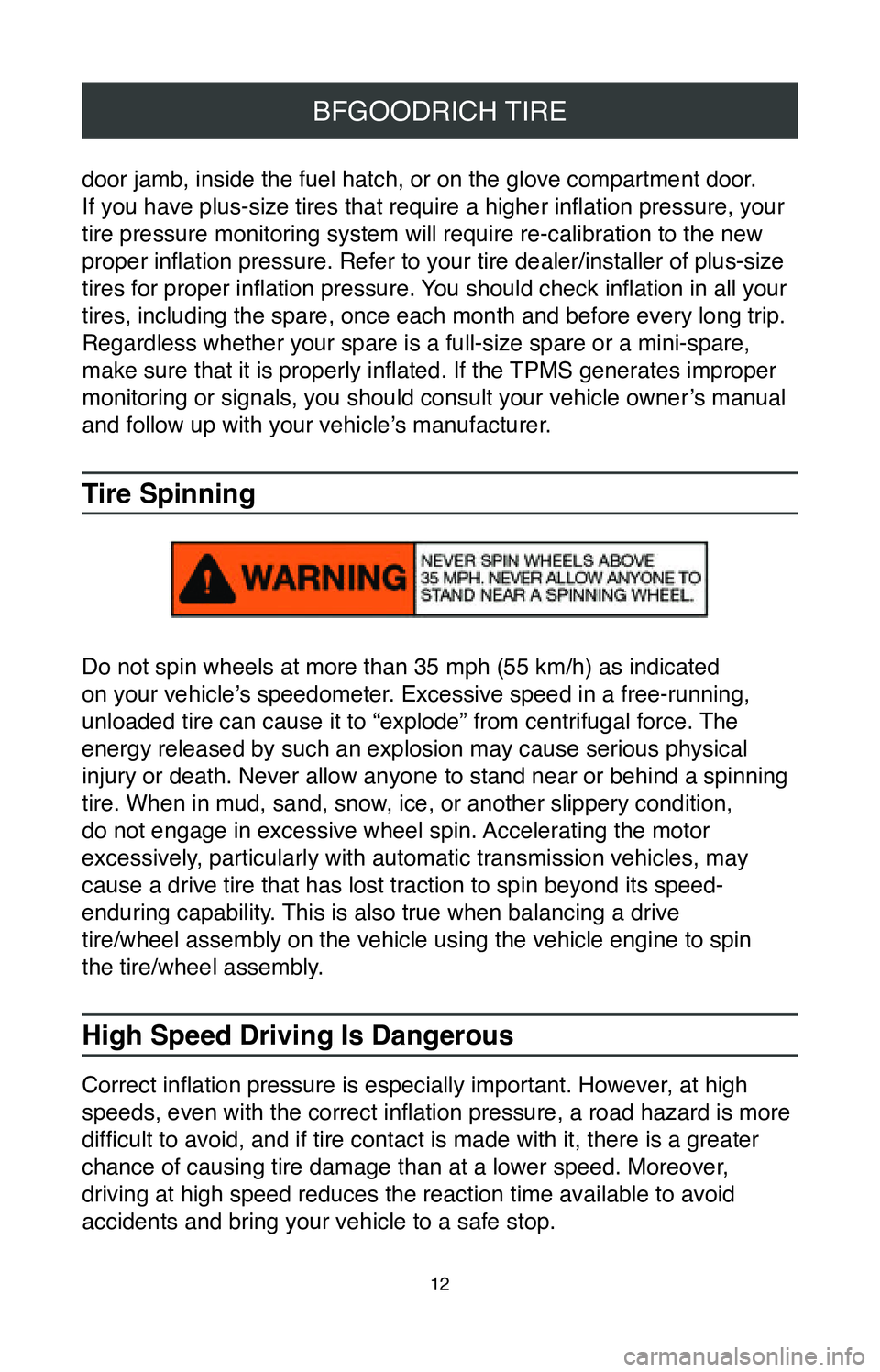
12
BFGOODRICH TIRE
door jamb, inside the fuel hatch, or on the glove compartment door.
If you have plus-size tires that require a higher inflation pressure, your
tire pressure monitoring system will require re-calibration to the new
proper inflation pressure. Refer to your tire dealer/installer of plus-size
tires for proper inflation pressure. You should check inflation in all your
tires, including the spare, once each month and before every long trip. \
Regardless whether your spare is a full-size spare or a mini-spare,
make sure that it is properly inflated. If the TPMS generates improper
monitoring or signals, you should consult your vehicle owner’s manual
and follow up with your vehicle’s manufacturer.
Tire Spinning
Do not spin wheels at more than 35 mph (55 km/h) as indicated
on your vehicle’s speedometer. Excessive speed in a free-running,
unloaded tire can cause it to “explode” from centrifugal force. The
energy released by such an explosion may cause serious physical
injury or death. Never allow anyone to stand near or behind a spinning
tire. When in mud, sand, snow, ice, or another slippery condition,
do not engage in excessive wheel spin. Accelerating the motor
excessively, particularly with automatic transmission vehicles, may
cause a drive tire that has lost traction to spin beyond its speed-
enduring capability. This is also true when balancing a drive
tire/wheel assembly on the vehicle using the vehicle engine to spin
the tire/wheel assembly.
High Speed Driving Is Dangerous
Correct inflation pressure is especially important. However, at high
speeds, even with the correct inflation pressure, a road hazard is more
difficult to avoid, and if tire contact is made with it, there is a greater
chance of causing tire damage than at a lower speed. Moreover,
driving at high speed reduces the reaction time available to avoid
accidents and bring your vehicle to a safe stop.
Page 15 of 260
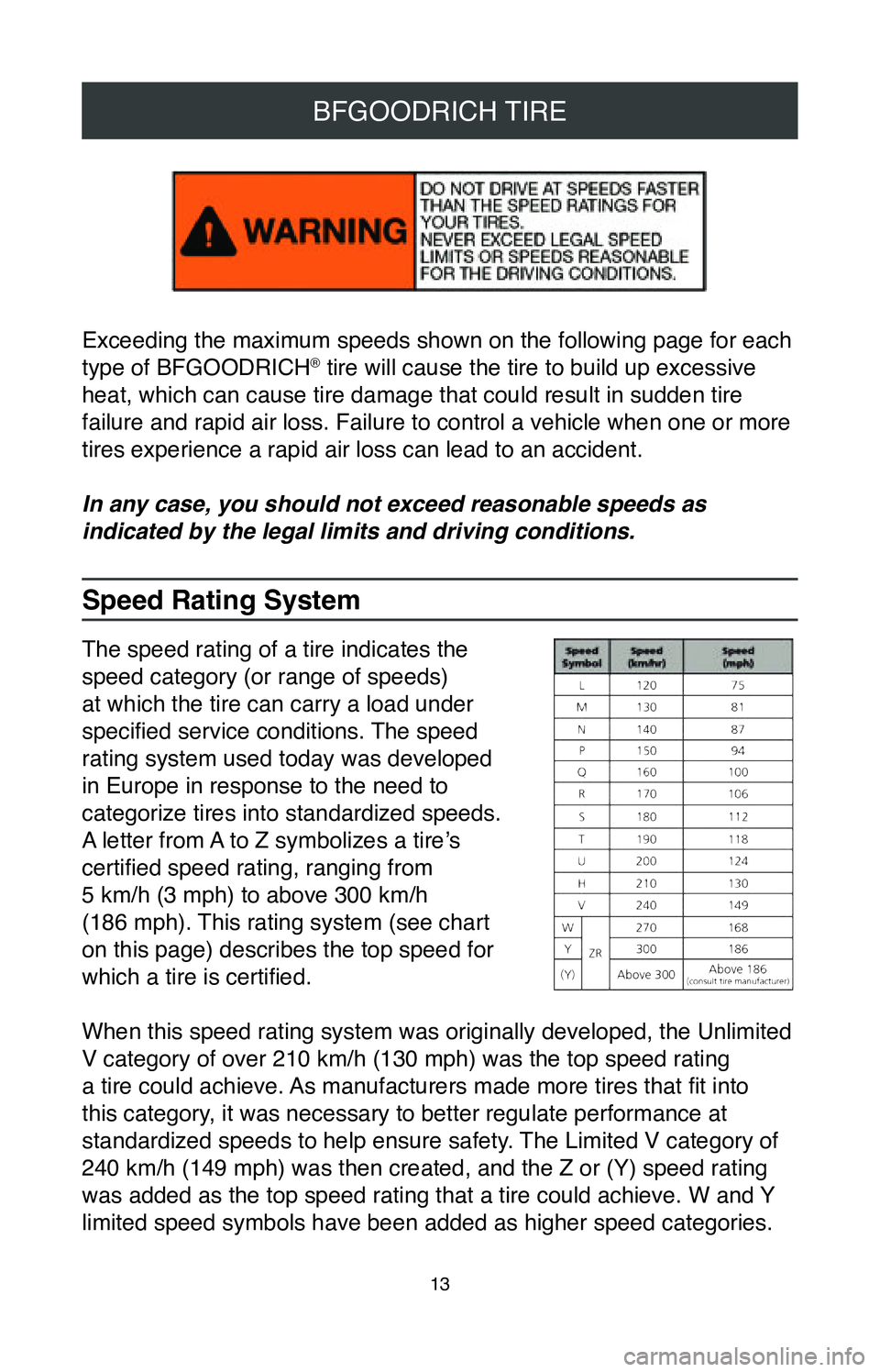
13
BFGOODRICH TIRE
Exceeding the maximum speeds shown on the following page for each
type of BFGOODRICH
Page 16 of 260
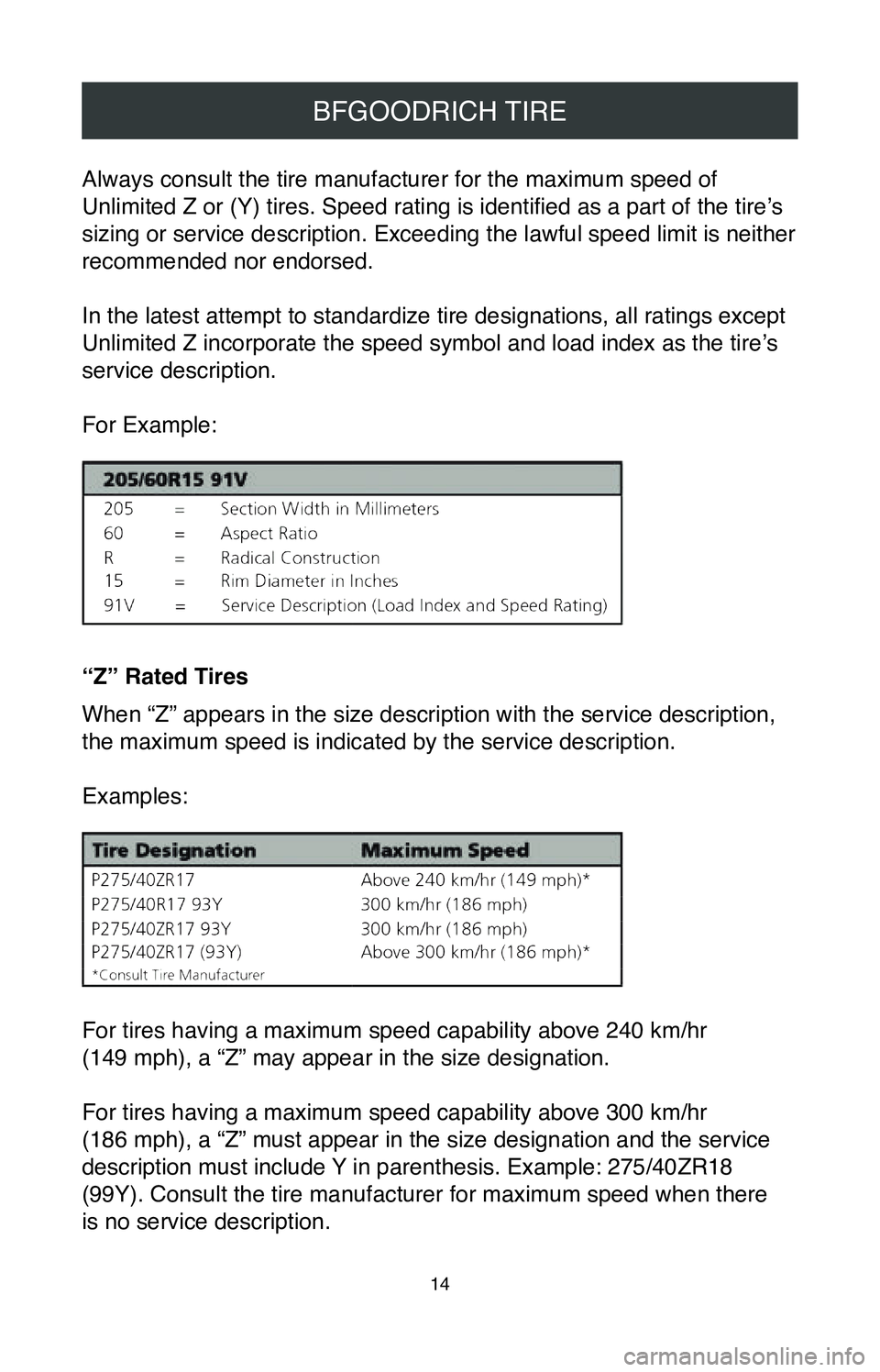
14
BFGOODRICH TIRE
Always consult the tire manufacturer for the maximum speed of
Unlimited Z or (Y) tires. Speed rating is identified as a part of the tire’s
sizing or service description. Exceeding the lawful speed limit is neith\
er
recommended nor endorsed.
In the latest attempt to standardize tire designations, all ratings exce\
pt
Unlimited Z incorporate the speed symbol and load index as the tire’ s
service description.
For Example:
“Z” Rated Tires
When “Z” appears in the size description with the service descript\
ion,
the maximum speed is indicated by the service description.
Examples:
For tires having a maximum speed capability above 240 km/hr
(149 mph), a “Z” may appear in the size designation.
For tires having a maximum speed capability above 300 km/hr
(186 mph), a “Z” must appear in the size designation and the service
description must include Y in parenthesis. Example: 275/40ZR18
(99Y). Consult the tire manufacturer for maximum speed when there
is no service description.
Page 17 of 260
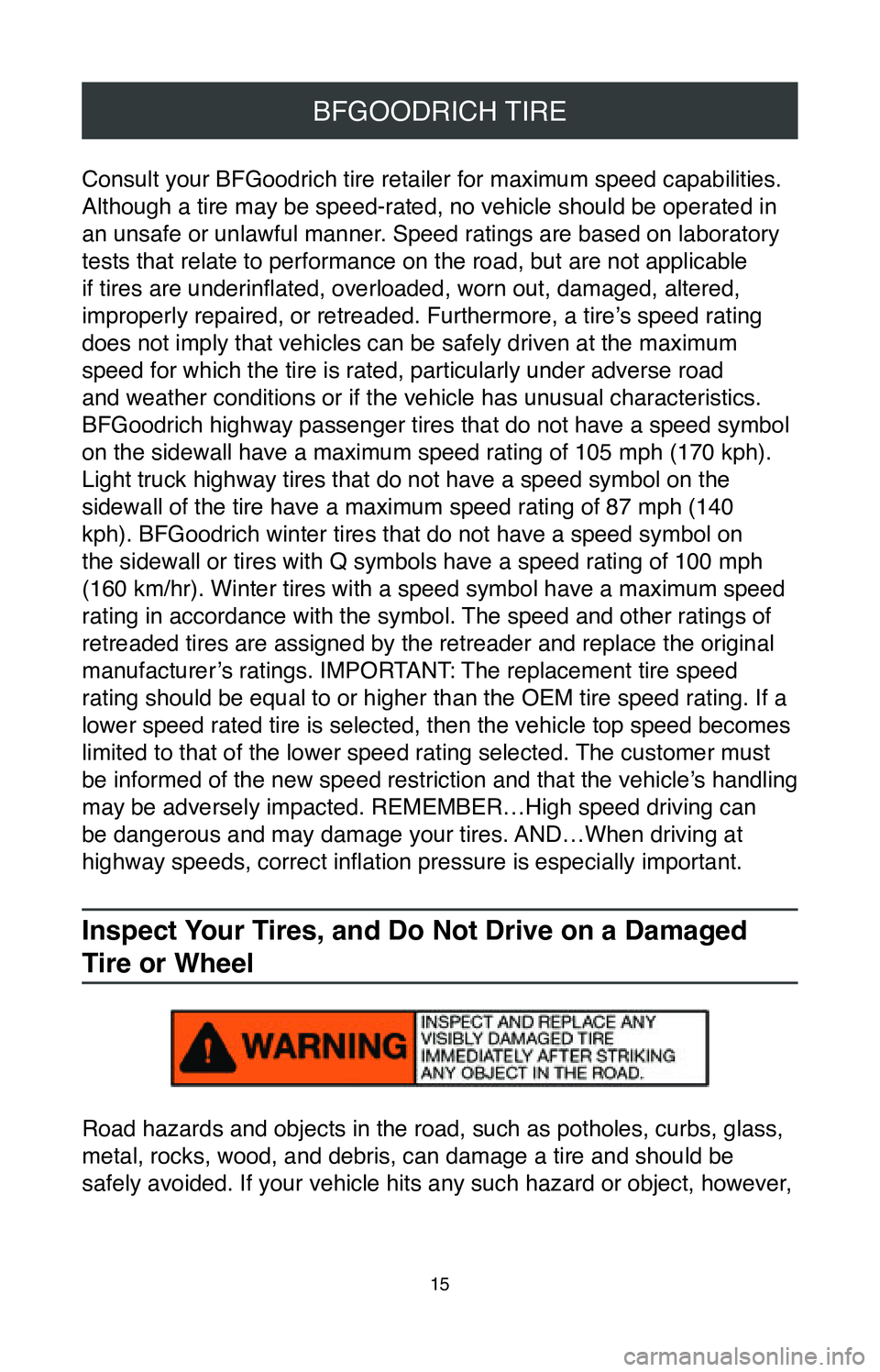
15
BFGOODRICH TIRE
Consult your BFGoodrich tire retailer for maximum speed capabilities.
Although a tire may be speed-rated, no vehicle should be operated in
an unsafe or unlawful manner. Speed ratings are based on laboratory
tests that relate to performance on the road, but are not applicable
if tires are underinflated, overloaded, worn out, damaged, altered,
improperly repaired, or retreaded. Furthermore, a tire’s speed rating
does not imply that vehicles can be safely driven at the maximum
speed for which the tire is rated, particularly under adverse road
and weather conditions or if the vehicle has unusual characteristics.
BFGoodrich highway passenger tires that do not have a speed symbol
on the sidewall have a maximum speed rating of 105 mph (170 kph).
Light truck highway tires that do not have a speed symbol on the
sidewall of the tire have a maximum speed rating of 87 mph (140
kph). BFGoodrich winter tires that do not have a speed symbol on
the sidewall or tires with Q symbols have a speed rating of 100 mph
(160 km/hr). Winter tires with a speed symbol have a maximum speed
rating in accordance with the symbol. The speed and other ratings of
retreaded tires are assigned by the retreader and replace the original
manufacturer’s ratings. IMPORTANT: The replacement tire speed
rating should be equal to or higher than the OEM tire speed rating. If a\
lower speed rated tire is selected, then the vehicle top speed becomes
limited to that of the lower speed rating selected. The customer must
be informed of the new speed restriction and that the vehicle’s handling
may be adversely impacted. REMEMBER…High speed driving can
be dangerous and may damage your tires. AND…When driving at
highway speeds, correct inflation pressure is especially important.
Inspect Your Tires, and Do Not Drive on a Damaged
Tire or Wheel
Road hazards and objects in the road, such as potholes, curbs, glass,
metal, rocks, wood, and debris, can damage a tire and should be
safely avoided. If your vehicle hits any such hazard or object, however,
Page 18 of 260
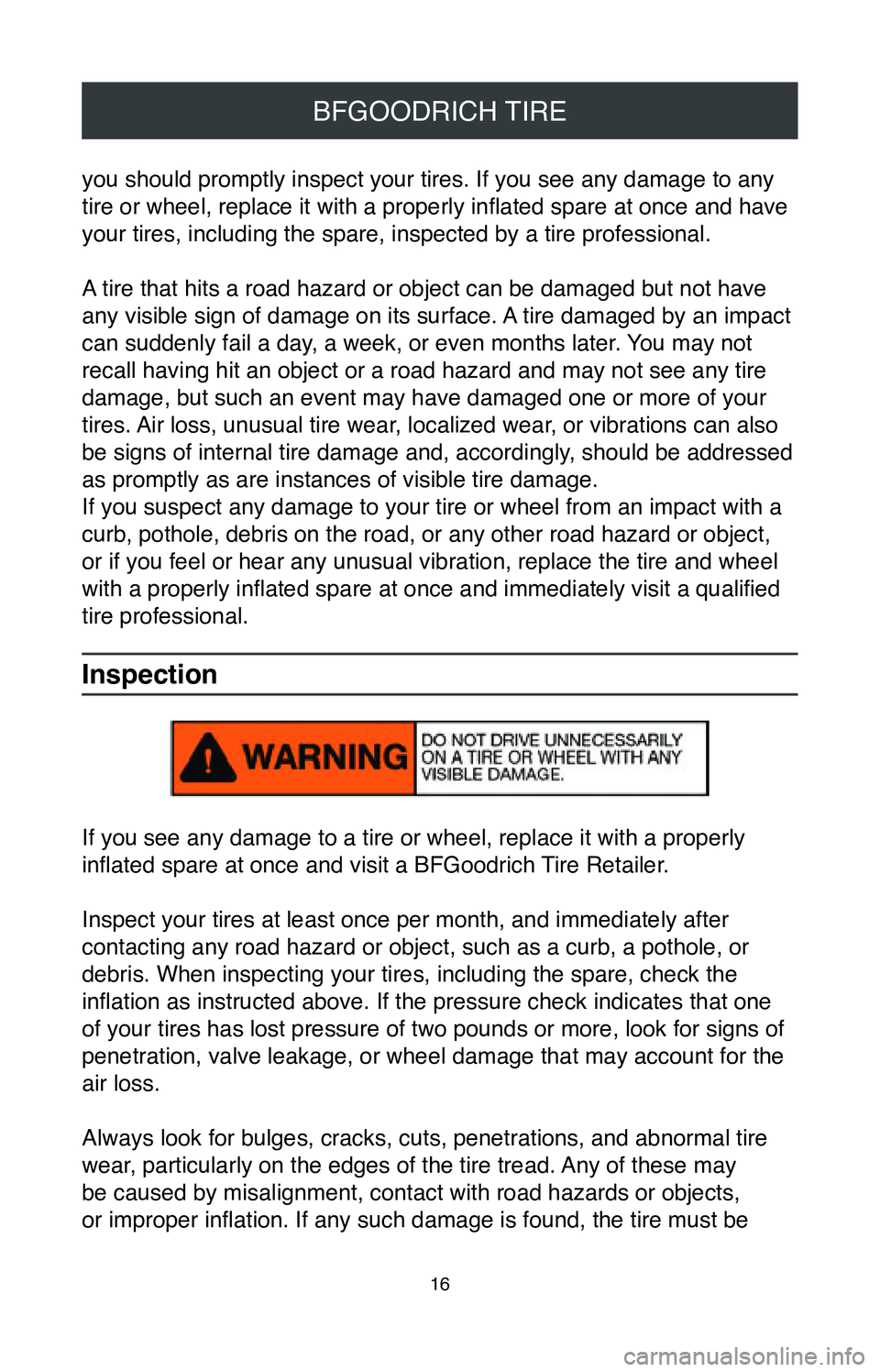
16
BFGOODRICH TIRE
you should promptly inspect your tires. If you see any damage to any
tire or wheel, replace it with a properly inflated spare at once and have
your tires, including the spare, inspected by a tire professional.
A tire that hits a road hazard or object can be damaged but not have
any visible sign of damage on its surface. A tire damaged by an impact
can suddenly fail a day, a week, or even months later. You may not
recall having hit an object or a road hazard and may not see any tire
damage, but such an event may have damaged one or more of your
tires. Air loss, unusual tire wear, localized wear, or vibrations can also
be signs of internal tire damage and, accordingly, should be addressed
as promptly as are instances of visible tire damage.
If you suspect any damage to your tire or wheel from an impact with a
curb, pothole, debris on the road, or any other road hazard or object,
or if you feel or hear any unusual vibration, replace the tire and wheel\
with a properly inflated spare at once and immediately visit a qualified
tire professional.
Inspection
If you see any damage to a tire or wheel, replace it with a properly
inflated spare at once and visit a BFGoodrich Tire Retailer.
Inspect your tires at least once per month, and immediately after
contacting any road hazard or object, such as a curb, a pothole, or
debris. When inspecting your tires, including the spare, check the
inflation as instructed above. If the pressure check indicates that one
of your tires has lost pressure of two pounds or more, look for signs of\
penetration, valve leakage, or wheel damage that may account for the
air loss.
Always look for bulges, cracks, cuts, penetrations, and abnormal tire
wear, particularly on the edges of the tire tread. Any of these may
be caused by misalignment, contact with road hazards or objects,
or improper inflation. If any such damage is found, the tire must be
Page 19 of 260
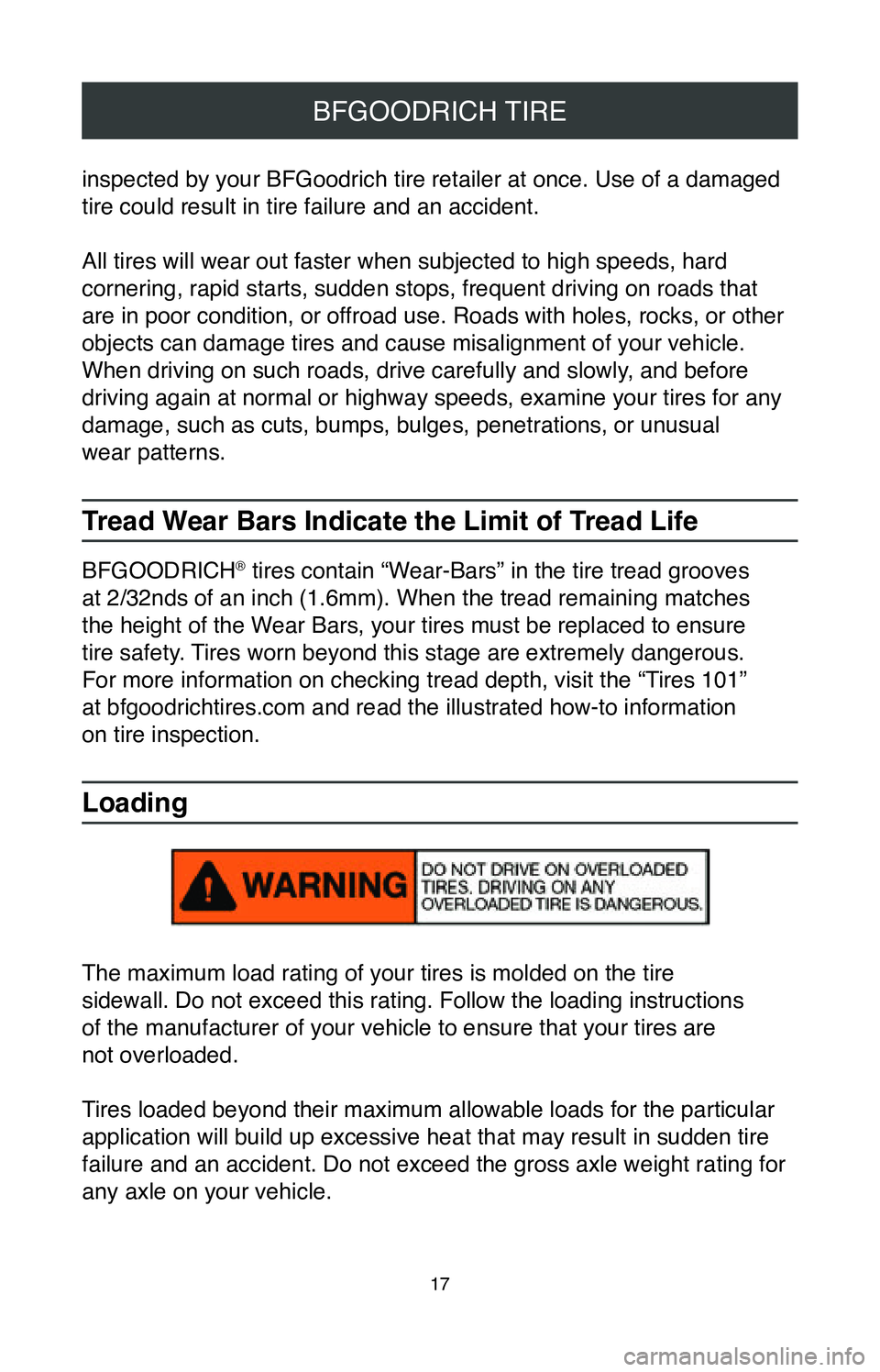
17
BFGOODRICH TIRE
inspected by your BFGoodrich tire retailer at once. Use of a damaged
tire could result in tire failure and an accident.
All tires will wear out faster when subjected to high speeds, hard
cornering, rapid starts, sudden stops, frequent driving on roads that
are in poor condition, or offroad use. Roads with holes, rocks, or other
objects can damage tires and cause misalignment of your vehicle.
When driving on such roads, drive carefully and slowly, and before
driving again at normal or highway speeds, examine your tires for any
damage, such as cuts, bumps, bulges, penetrations, or unusual
wear patterns.
Tread Wear Bars Indicate the Limit of Tread Life
BFGOODRICH® tires contain “Wear-Bars” in the tire tread grooves
at 2/32nds of an inch (1.6mm). When the tread remaining matches
the height of the Wear Bars, your tires must be replaced to ensure
tire safety. Tires worn beyond this stage are extremely dangerous.
For more information on checking tread depth, visit the “Tires 101”
at bfgoodrichtires.com and read the illustrated how-to information
on tire inspection.
Loading
The maximum load rating of your tires is molded on the tire
sidewall. Do not exceed this rating. Follow the loading instructions
of the manufacturer of your vehicle to ensure that your tires are
not overloaded.
Tires loaded beyond their maximum allowable loads for the particular
application will build up excessive heat that may result in sudden tire \
failure and an accident. Do not exceed the gross axle weight rating for \
any axle on your vehicle.
Page 20 of 260
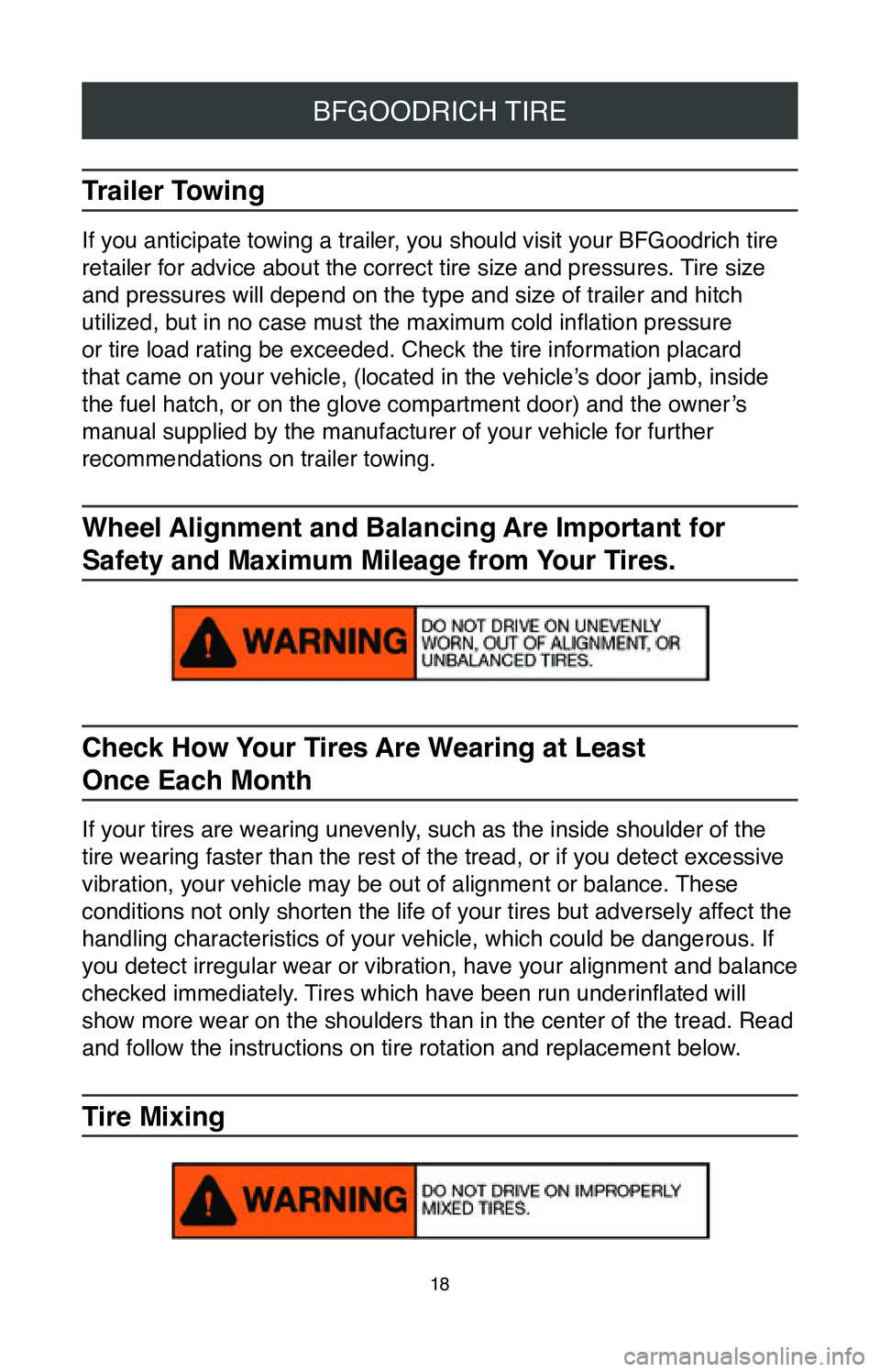
18
BFGOODRICH TIRE
Trailer Towing
If you anticipate towing a trailer, you should visit your BFGoodrich tire
retailer for advice about the correct tire size and pressures. Tire size
and pressures will depend on the type and size of trailer and hitch
utilized, but in no case must the maximum cold inflation pressure
or tire load rating be exceeded. Check the tire information placard
that came on your vehicle, (located in the vehicle’s door jamb, inside
the fuel hatch, or on the glove compartment door) and the owner’s
manual supplied by the manufacturer of your vehicle for further
recommendations on trailer towing.
Wheel Alignment and Balancing Are Important for
Safety and Maximum Mileage from Your Tires.
Check How Your Tires Are Wearing at Least
Once Each Month
If your tires are wearing unevenly, such as the inside shoulder of the
tire wearing faster than the rest of the tread, or if you detect excessi\
ve
vibration, your vehicle may be out of alignment or balance. These
conditions not only shorten the life of your tires but adversely affect the
handling characteristics of your vehicle, which could be dangerous. If
you detect irregular wear or vibration, have your alignment and balance
checked immediately. Tires which have been run underinflated will
show more wear on the shoulders than in the center of the tread. Read
and follow the instructions on tire rotation and replacement below.
Tire Mixing